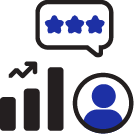KEY TAKEAWAYS:
-
Economic Buyers care about how your solution aligns with their top business priorities, not the product itself. Use tools like the Value Pyramid to connect your offering to their corporate objectives and initiatives.
-
Tailor your messaging to the executive’s role and business needs. Establish credibility, demonstrate business acumen, and use metrics to prove your value.
-
Engage through diverse channels—direct contact, leadership introductions, assistants, and strategic partners. Persistence and varied approaches significantly increase your chances of success.
-
Learn how budgets are structured and secured within the organization. Ask targeted questions during discovery to uncover funding processes and identify Economic Buyers who can allocate resources to your solution.
Anyone versed in MEDDIC and its variations knows the importance of engaging with the Economic Buyer. Leveraging them can be the key to closing your deal and its subsequent success - but how can you go about that?
MEDDIC creator, the amazing Dick Dunkel, took the stage at MEDDICON 2 to shed some light on Economic Buyer engagement and how to leverage it. If you missed the session, or just want a refresher, keep reading to uncover the key takeaways!
What we need to remember when selling to the Economic Buyer is that in the current selling environment, executives have to be incredibly focused. They’re experiencing budget cuts, with purchases being more scrutinized than ever before. Important decisions are being delayed, and purchasing authority has been lowered. The reality is that executives are under incredible pressure today: they’re being benchmarked against peers and measured against targeted KPIs. And so, they are consulting their trusted advisors, looking for insights and answers to address their top business challenges.
More than ever, executives need to prioritize. And so do you!
While you might think that all you need to do is show an executive your amazing product and they will immediately see the value, the harsh reality, Dick points out, is that “Economic Buyers and executives do not care about your product, they care about what your product can do for them.”
To surmount this, sellers need to increase their understanding of how they can strategically align to the priorities of their economic buyers and elevate their engagements so that they are able to align their offerings to those strategic priorities.
It’s good to remember the power held by the Economic Buyer. The Economic Buyer can:
-
Override or veto recommendations
-
Move money either to or from your project
-
Direct key players who can make or break your deal
-
Accelerate your sales cycle
-
Increase your deal size
-
Refer you to fellow executives (inside or outside the organization)
Obviously, engagement with the Economic Buyer is critical, yet only 10% of executives rate sales calls as valuable enough to have earned the time they spent on them.
So where is the disconnect here? Why do most sellers miss the mark when it comes to initiating and maintaining senior level relationships? The reality is that we tend to gravitate towards our comfort zone. That is usually with mid-level managers, the people who actually care about the features or functions of your solution. As a result, most sellers do not spend a lot of time engaging with executives. The way to overcome this is to realize that engaging with executives is a different experience, and so requires a different skillset.
Five Common Mistakes made when engaging with executives include:
- Not identifying the senior leaders who have the potential to influence your decision; it’s not just the immediate decision maker, but other influential executives.
- Not researching the strategic priorities of the business and aligning your potential solution to those priorities.
- Ineffective communication - not communicating to executives as an executive.
- Not taking a multi pronged approach to account penetration
- Not uncovering potential funding sources
Let’s go step-by-step and look at how you can overcome these mistakes.
#1 Identify the Senior Leaders who can Influence your Decision
Here, you need to think beyond the users that are just affected directly by the change, and look to those affected by any downstream or upstream consequences of the change. Learn those people’s names and titles; having this knowledge will show you in a different light as a seller. If you’re researching public companies, you can dive into their 10ks and understand how those people are compensated. To effectively communicate with them, you need to understand their respective roles. You might need to reach beyond your customer base to learn these things, but the information is out there and you can gain a competitive advantage by finding it out.
#2 Align to your Target’s Account Strategic Priorities
This could be the most important point of all! Look for strategies and initiatives; do the research, read the 10k, look at the earnings announcement and look for those strategies and initiatives that are directly associated with what your offering can provide. To accomplish this, you can leverage research tools - Dick recommends Databook. You can also leverage what you’ve learned from your installed customer base and identify the executives that are attached to those initiatives. That is how you can identify who the key players are to whom you should be reaching out.
To figure out the best messaging when reaching out to these key players, you can use a Value Pyramid. It illustrates your understanding of their business and sets an expectation for how you are going to engage, that you will strategically align with the customer. To ensure that the problems your solution solves are directly attached to what is most important to their business, you can use the Value Pyramid as a guide.
For example, let’s say that your customer’s Corporate Objectives include Shareholder Value. The subsequent business strategy could be Customer Growth and Retention. The related Initiative could be to Improve on-time delivery by X percent by Y date. From this above research, you can create a hypothesis about the Execution Challenges and Capabilities Needed. This helps you come to the customer with a point of view on how you can help. This leads to discovery, which leads to requirements, which leads to a bigger opportunity!
By working from the top of the pyramid down, you can align your offering with your target’s strategic priorities.
#3 Effective Communication
When speaking to executives, you need to remember who you’re speaking to, or else they won’t engage. You need to leverage your hypothesis in a tailored fashion. A message crafted for an executive needs to be phrased in a way that makes it clear that it was intended for them and them alone. Be ready to share how you help similar executives in their industry, and remember that an executive won’t care about your product or your title. An executive is only interested in whether you’ve done this before, if you understand their business, and is there potential there for you to help them? Engagement happens when they believe you understand their business, and they have reason to believe that you can help. Dick shared a framework for effective communication:
-
Establish credibility - maybe share a mutual point of contact.
-
Demonstrate business acumen
-
Have a Proof Point (think about metrics!)
-
Ask about scheduling a brief introduction via their assistant.
#4 Taking a Multi-Pronged Approach to Making Contact
Remember, executives are busy and skeptical. They rely on trusted advisors to help filter information, so you need to coordinate your outreach across multiple channels and vectors. You’re 3x more likely to make contact if you do! To do this, you can:
-
Reach out directly
-
Leverage your leadership team
-
Work with their assistant
-
Consider working through their strategic partner
-
Leverage customers and events
Two crucial things to keep in mind: don’t give up, and don’t limit yourself!
#5 Uncover Potential Funding Sources
This can reveal essential information about the Decision Process. It will help you to:
-
Identify the Economic Buyer key stakeholders
-
Prioritize your opportunities
-
Manage your timeline
Funding structures define how funds are allocated and made available. Naturally, they vary by organization, business unit and department, so it’s good to uncover how they are organized at your prospect’s company, as it can give you a new perspective on your opportunity. You can learn about this by asking questions during the discovery process. Some such questions could be:
- Is there a defined budget?
- How are funds secured for unplanned investments?
- If we were able to show that a larger investment would give a much greater return, who would have to approve that increased spending?
To have an impact in this area, keep in mind that you can influence the decision process. The way that you sell and the way you articulate your value can impact who you get delegated to. Think: are you communicating at a level that will open the door to senior level people? That can affect the budget and the funds available for your solution.![]() Essentially:
Essentially:
Executives will engage when you focus on their priorities and their objectives, when you share your message using their language and their KPIs that should share credible examples of where you've done this before.
Dick also shared his recommended timeline for Economic Buyer engagement, shown below! It highlights Executive Alignment as an important step pre-commitment to determine whether something is worth investing your time and energy into. ![]() Figuring out how to engage with the Economic Buyer can be intimidating, but we hope that, equipped with the information in this article, you feel ready to take it on!
Figuring out how to engage with the Economic Buyer can be intimidating, but we hope that, equipped with the information in this article, you feel ready to take it on!





.png)





.png)
























%201.png)








.png)

.png)
.png)
.png)